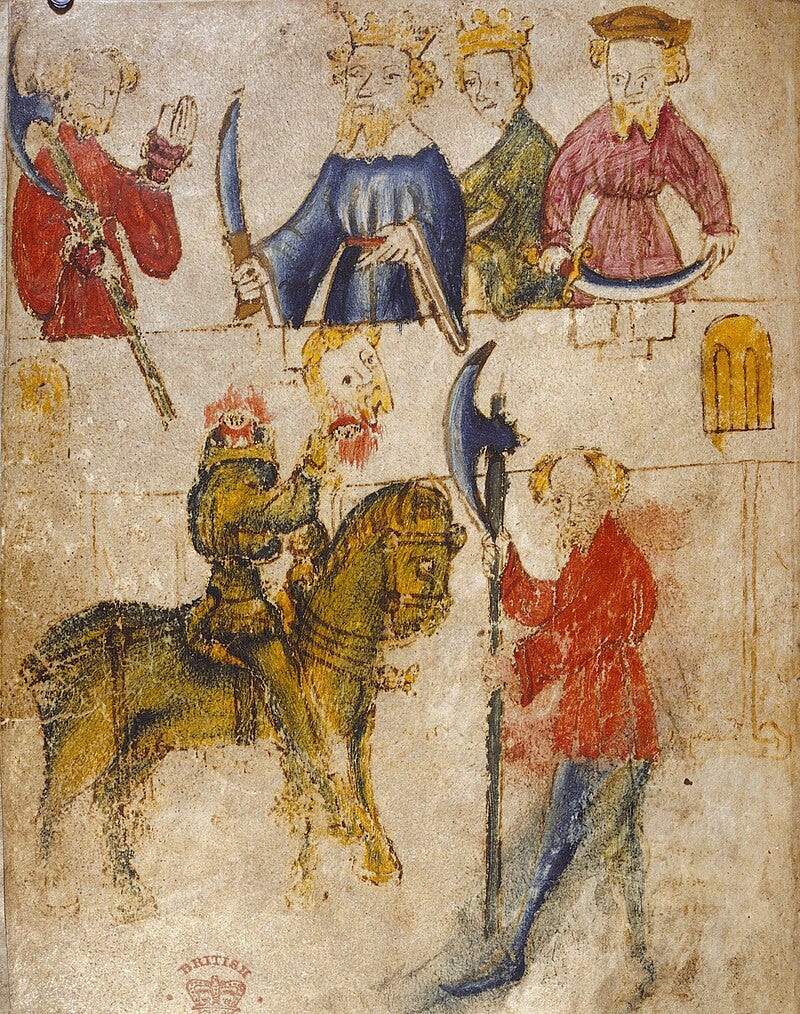Last year, after shotgunning Cormac McCarthy’s career into my eyes and ears and mouth, I found myself at a loss of what to read. I would pick up this or that, read for ten or twenty pages, and then just listlessly wander off to other words.
And so, as one does, I retreated to Old and Middle English poetry.
It made more sense at the time. Trust me.
Thus and so, I read a handful of translations of Sir Gawain and the Green Knight as well as Beowulf, The Death of Arthur, Pearl, and The Owl and the Nightingale, and the Mabigonion, and so on. This led me back to The Odyssey and The Iliad and a few other ancient texts you may have been assigned in school at some point, that you may have ignored entirely. I went onto read quite a lot of Arthuria, including modern adaptations, and then did some study on sources and archaeology and all sorts of fun, normal things like that.
What do you do for fun?
And then I watched the notable film adaptation of Sir Gawain and the Green Knight by David Lowery.
And so I want to talk a bit about Sir Gawain and the Green Knight in two parts. First as a poem and then as the adaptation.
Sound all right?
Splendid.
Sir Gawain
a bit of background
The Arthurian Legends go back to the 5th Century, after Rome abandoned Britain in its plight against various invaders and rivals like the Picts, Saxons, and Irish.
Since I don’t mean for this to be a history lesson, I’ll try to be brief as I can but I think this is important to the discussion of the text and the subsequent adaptation.
In Cornwall and/or Wales, there appeared a warlord known as Arthur (Artorius, Arturus, Artur, etc) who was instrumental and halting the Saxon invasion across Britain. There are various forms of evidence for this, including archaeological, though much of it is contested by would-be skeptics.
In any case, the stories of Arthur raced across Britain and belong both to the Welsh and the Cornish, though both would contest the claim of the other. The story of Arthur gained popularity once more with the invasion of the Vikings, when the British found comfort and connection in these old legends. Ironically, of course, Arthur was attempting to banish the people who now claimed him.
After the days of Viking Invasions, a man named Geoffrey of Monmouth (Welshman, as it goes) wrote the History of the Kings of Britain, which, once again, popularized Arthur. The popularity cannot be overstated, as over 200 copies of the text remain with us today. I can’t really explain how unusual this is, but Beowulf, for example, exists as a single, incomplete copy at present (we’ll talk about him another day).
Well, this popularity spread across Europe. Most notably to France and Germany. The French laid their own claim on Arthur by creating Lancelot du Lac, the most famous of Arthur’s knights and the lover of the Queen Guinevere (Gwynnever, Gwenivar, etc etc etc). And so after Arthur kicked around Europe for a few centuries, he came home to Britain with Sir Gawain and the Green Knight.
This is a notable moment in literary history, for those who care about such things. At this point in time, most of the written Arthurian texts were written in non-British languages. Arthur, who began life as a Cornish or Welshman had become Continental.
This simply would not do.
At the same time, Edward III was the king of England. Like his grandfather, Edward I (the name Edward was an Old English throwback, as Henry III was quite enamored with those pre-Norman days [perhaps a theme among royals and significants is their belief in and love of the heroic past]), Edward III was a mighty and significant king (Edward II was a disaster for England, which we don’t have time to get into).
His reign saw England rise to one of the most powerful nations in Europe. His seeming invulnerability in war—prompted by his own propaganda—led many to consider him Arthur reborn. The once and future king revived, as was the prophecy.
During Edward III’s reign or the reign of his son, the sad and disastrous Richard II (in many ways, he was the opposite of an Arthur figure [though his father, The Black Prince, was very much the rising star of Britain, a new Arthur, like his father, though he was taken by death too soon], which, along with many other factors, led to the usurpation of the throne by his cousin, Henry IV, himself a self-styled new Arthur, a throwback to his illustrious grandfather, Edward III, whose son would more fully embody Arthur to many), Sir Gawain and the Green Knight came into being, written in Middle English (the North West Midlands dialect, spoken then on the border of England and Wales) in alliterative verse—an English style, distinct from the French and Germanic romances.
What we have in Sir Gawain and the Green Knight is a reclamation of Arthur. We see this in its Celticness. We see this in the way Lancelot is never mentioned or even present. Rather, Sir Gawain, from Orkney in Scotland, is said to be the greatest of Arthur’s knights. The most chivalrous, the most pious, the most handsome.
Even the beheading game, which comes from the Ulster Cycle of Irish mythology, which filtered across Europe over the centuries. And while Ireland is not British or English, it is Celtic, just as Arthur, the Welsh or Cornishman, was.
The French and German romances include beheading games of their own, but the Gawain Poet brought the trope home to the land of the Celts from the continent and gave the game to Gawain.
The structure of the middle of the poem owes much to the Mabinogion (a collection of Welsh stories and legends compiled in Middle Welsh in the 12th/13th centuries) as well.
And even the Courtly Love genre is brought home, with Gawain showing proper love and devotion to the lady while still honoring the lord. Which, in a way, is a subversion of the Lancelot/Guinevere dynamic, which is the seed of Arthur’s tragic downfall.
As if this whole thing is about the elevation of a homegrown knight rather than some foreign upstart!
And so we see in Sir Gawain and the Green Knight a renaturalization process happening. Arthur has spread his wings and gone far from home, but the Gawain Poet sought to bring him back and settle him in England, in Wales as a Celtic and English hero.
the poem and its translations
There are as many translations of Sir Gawain and the Green Knight as there are verses within the poem, but there are likely only a few major ones that you’ve come across. There are all kinds of reasons for this, but the main one is that it’s tricky to capture the alliterative rhythm in the original and put it into modern English.
Because of this, translators like JRR Tolkien (yes, that Tolkien) translated the poem in prose.
And, in many ways, his translation is one of the best. He captures the humor of the poem, the playfulness of it. He also has a strong ear for language, and so while it’s not in meter, it is rhymic and musical. The alliterative style is kept, for the most part, giving a sort of galloping gleefulness to the poem now given in prose.
Which is warranted.
Sir Gawain and the Green Knight is very funny! It’s full of the absurd and the bawdy, touching on cliches and tropes of the genre of the Chivalric Romance, while also offering audiences quite a bit of playfulness.
Which is an important aspect of these ancient poems. You must understand, people didn’t read poetry. Poetry was performed for them. I’ll sidestep a discussion of medieval literacy and just say that the performance of these works was for high and low, for the nun and the harlot. The success of a work depended, in part, on the work’s ability to please all stations, all peoples simultaneously.
Bernard O’Donaghue brings the poem back to verse but loses alliteration and I think he mostly fails, honestly, and sort of ruins the rhythm and texture of the poem.
My favorite translation is Simon Armitage, who keeps the rhythm and alliteration and even some of the locality of the poem.
It’s the one I recommend picking up if you’re curious about reading an ancient epic. I just reread it this morning and it’s such a joy and delight to live inside this rhythm.
And if you’re interested in alliterative verse, Middle English, Arthuria, or even just want to get the foundation for the 2021 film, I’d say it’s well worth it. Takes maybe an hour or two to read.
You’ll find humor, romance, bisexuality, violence, and the gripping story of failure.
For, in many ways, Sir Gawain and the Green Knight is about failure. While Gawain is the greatest of knights, even he fails in his quest. Though, as it happens, the failure is its own success.
There’s a dramatic irony to the whole affair, because Gawain cannot succeed without failing some aspect of chivalry. He must keep the sash from the lady of the castle but he must also keep it secret from her husband, who he has promised to share anything given to him.
To fulfil his promise to the lord means betraying the promise of the lady.
This may lead into Sir Thomas Malory’s own Morte d’Arthur, which is the ultimate compendium of Arthuria and its chivalric demands, its idealized world.
Malory himself was a rapist and murderer, a knightly failure, who wrote Morte d’Arthur while in prison for his crimes, elevating and codifying chivalry for the masses. A man who failed his duty reimagining a world when knights were not ravishers, when the world was not in decline, when morality was at a great Christian height.
It is the ideals of chivalry and knighthood that may be on trial in Sir Gawain and the Green Knight, more even than Gawain himself.
But, too, there’s the Christian element which cannot be forgotten.
For we are all born damned and only by striving every day for all our lives will we find salvation.
And so failure and confession and absolution are all tied as one in the resolution. A baptism by trial, by blood, and Gawain rises from his would-be death as the purest of all knights.
You could almost call it Christlike, were you the type to make such statements.
Anyway, past the paywall, we’re onto the movie.
Buckle up.
The Green Knight
Keep reading with a 7-day free trial
Subscribe to Wolf to keep reading this post and get 7 days of free access to the full post archives.




